Related Research Articles

The Boletaceae are a family of mushroom-forming fungi, primarily characterised by small pores on the spore-bearing hymenial surface, instead of gills as are found in most agarics. Nearly as widely distributed as the agarics, the family is renowned for hosting some prime edible species, such as the Cep or King Bolete , highly sought after by mushroom hunters worldwide. A number of rare or threatened species are also present in the family, that have become the focus of increasing conservation concerns. As a whole, the typical members of the family are commonly known as boletes.

The Amanitaceae is a family of mushroom-forming fungi. The family, also commonly called the amanita family, is in order Agaricales, the gilled mushrooms. The family consists primarily of the large genus Amanita, but also includes the smaller genera Amarrendia, Catatrama, Limacella, Limacellopsis, Saproamanita, Torrendia and Zhuliangomyces. Both Amarrendia and Torrendia are considered to be synonymous with Amanita but appear quite different because they are secotioid.
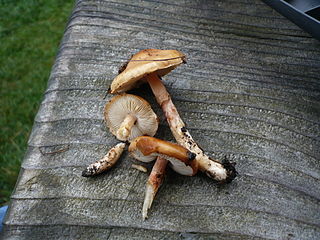
Limacella is a genus of mushroom-forming fungi in the family Amanitaceae in order Agaricales. Some of the species have been classified as members of genus Lepiota. Limacella was described by mycologist Franklin Sumner Earle in 1909.

Amanita gemmata, commonly known as the gemmed amanita or the jonquil amanita, is an agaric mushroom of the family Amanitaceae and genus Amanita. The fruit body has a cap that is a dull to golden shade of yellow, and typically 2.5–12 cm (1.0–4.7 in) in diameter. The cap surface is sticky when moist, and characterized by white warts, which are easily detached. It is initially convex, and flattens out when mature. The flesh is white and does not change colour when cut. Gills are white and closely spaced. The stem is pale yellow, and measures 4–12 cm (1.6–4.7 in) long by 0.5–1.9 cm (0.2–0.7 in) thick. The partial veil that covers the young fruit body turns into the ring on the stem at maturity. The spore print is white, while the spores are roughly elliptical, and measure 8–10 by 6.5–7.5 μm.
Yang Hao, often known by the title of Prince of Qin (秦王), was one of the claimants of the throne of the Chinese Sui Dynasty at the dynasty's end.
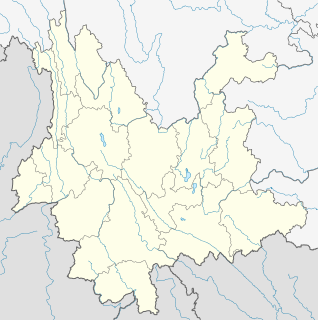
Fuxian Lake stretches out through Chengjiang, Jiangchuan and Huaning Counties in Yunnan Province, spanning an area of 212 square kilometers. The lake is ranked third-largest in Yunnan, after Dian Lake and Erhai Lake. Also the deepest lake in Yunnan, it is 155 meters deep at its greatest depth. It is also the third-deepest fresh water lake in China, after Tianchi and Kanas Lake.
Catatrama is a fungal genus in the family Amanitaceae, order Agaricales. Originally a monotypic genus with Catatrama costaricensis, found in Quercus pilarius forest in Costa Rica. In 2007, the species was reported from Brazil. Since then 2 additional species, one from Australia and one from India have been recognized.
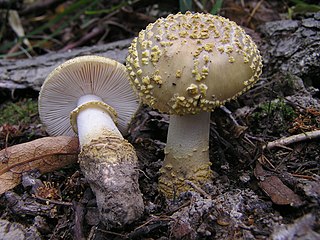
Amanita franchetii is a species of fungus in the family Amanitaceae. It was given its current name by Swiss mycologist Victor Fayod in 1889 in honor of French botanist Adrien René Franchet. A. franchetii occurs in Europe and North Africa with oaks, chestnuts, and pines.
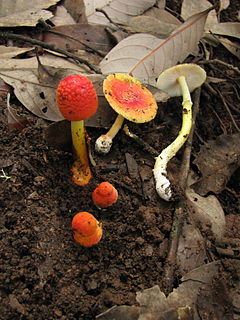
Amanita rubrovolvata, commonly known as the red volva amanita, is a species of fungus in the family Amanitaceae. First described scientifically by the Japanese mycologist S. Imai in 1939, it is widely distributed in eastern Asia. The fungus produces small to medium-sized mushrooms, with reddish-orange caps up to 6.5 mm (0.26 in) wide. The stems are up to 100 mm (3.9 in) tall, cream above the ring and cream to yellowish below it. The stem ends in a roughly spherical bulb at the base, which is covered with bright orange patches. Neither edibility nor toxicity have been established for the fungus, but it is suspected to be associated with neurological anomalies. Several molecular studies have confirmed the mushroom's classification in the subgenus Amanita of the genus Amanita, along with closely related species such as A. muscaria.
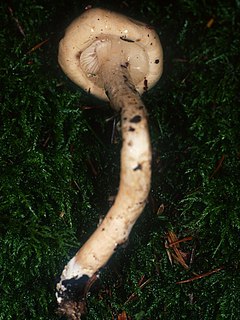
Limacella illinita, or Overflowing Slimy Stem, is a mushroom in the genus Limacella, in the family Amanitaceae.

Limacella glischra is a mushroom species in the family Amanitaceae. It was first named as a species of Lepiota by Andrew Price Morgan in 1906; William Alphonso Murrill transferred it to Limacella in 1914.

The genus Saproamanita contains about 24 species of agarics and is one of six genera in the family Amanitaceae. The others are Amanita, Catatrama, Limacellopsis, Zhuliangomyces and Limacella. Saproamanita are the saprophytic species in the Tribe Amaniteae, separately classified from the ectomycorrhizal species in the genus Amanita.
Amanita pallidorosea is a mushroom of the large genus Amanita, which occurs under beech and pine in China and Japan. It is closely related to the destroying angel A. bisporiga.
Amanita subpallidorosea is a mushroom of the large genus Amanita, which occurs under oaks in southern China and Taiwan. It is closely related to the destroying angel mushrooms A. virosa and A. ocreata.
Amanita subfuliginea is a mushroom of the large genus Amanita, which occurs central and southern China. It is closely related to the east Asian death cap A. fuliginea.
Amanita griseorosea is a mushroom of the large genus Amanita, which occurs under beech in southern China. It is closely related to A. molliuscula.
Amanita molliuscula is a mushroom of the large genus Amanita, which occurs under beech in Shaanxi Province in China. It is closely related to A. griseorosea.
Amanita parviexitialis is a mushroom of the large genus Amanita, which occurs under beech in southern China.
Sutorius magnificus, known until 2014 as Boletus magnificus, is a species of bolete fungus in the family Boletaceae native to Yunnan province in China. It was transferred to the new genus Neoboletus in 2014, and then Sutorius in 2016.

Zhuliangomyces is a genus of mushroom-forming fungi in the family Amanitaceae in order Agaricales. Analysis of DNA sequences was used to show that Zhuliangomyces was separate from Limacella which is similar in appearance and the genus name Myxoderma was adopted. The name Myxoderma was previously used for a genus of Cyanobacteria and the fungal generic name was replaced by Zhuliangomyces.
References
- ↑ Yang ZJ, Cai Q, Cui YY (2018). "Phylogeny, diversity and morphological evolution of Amanitaceae". Biosyst. Ecol. Ser. 34: 359–380.
- ↑ Cui YY, Cai Q, Tang LP, Liu JW, Yang ZL (2018). "The family Amanitaceae: molecular phylogeny, higher-rank taxonomy and the species in China". Fungal Diversity. 91: 5–230. doi:10.1007/s13225-018-0405-9. S2CID 52048762.
| This Amanitaceae article is a stub. You can help Wikipedia by expanding it. |